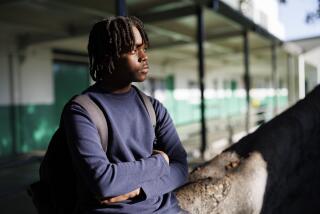Parent Hopes Music Bridges Gap Between Latino, Black Pupils : Education: Segregating students for instruction in Spanish sends wrong signal, father says. He launches fund-raising effort to buy and rent instruments.
- Share via
When Michael Dickerson took his 5-year-old twins to Watts’ Grape Street Elementary School for their first day of kindergarten this month, he was disturbed to see Latino childrengoing off in one direction and African-American youngsters going in another.
Even after Principal Alvis Andrews told him the segregation was necessary so that African-American students could be taught in English and Latino students in Spanish, Dickerson remained upset.
“It’s not a very good message to send 5-year-olds on the first day of school,” Dickerson said. “I got a little ticked-off. I asked myself how we could bring these kids together before the misunderstanding begins.”
So instead of dropping his concern, Dickerson decided that music could be the perfect bridge-builder between children of the two ethnic groups and has launched a drive to raise $700 to buy and rent instruments and music books.
On Monday afternoon, at the kick-off for a fund-raising drive--the first step in realizing Dickerson’s dream--about 120 of the school’s third- and fourth-graders assembled in the auditorium to listen to Latin jazz musician Poncho Sanchez and his band play and talk about music.
“I know how it is to grow up around here,” Sanchez, who grew up in a Norwalk barrio, told the students. “By studying music and learning to play, I have been able to travel the world. We know how it is for you. We were just like you. We want you to know there is a way to succeed in life. We did it. I know you can.”
So far, Dickerson’s efforts have raised no money, although he said he hopes the publicity from the show, “Jazz, Rap and Salsa Community School Dollars Day,” will lead to donations.
The money raised will go toward renting trombones, tubas, saxophones and other instruments for a year for fourth- and fifth-graders, purchasing music books and buying 75 recorders--flute-like instruments--for each third-grader. A music teacher comes to the school twice a week.
“The way we group our students, they are isolated from each other,” Andrews said. “But the music will allow for a mixture in an area where language doesn’t predominate. Music is a big thing in both the Latino and African-American cultures, and if you think of something like rap music, you realize it crosses cultural lines like perhaps nothing else does.”
Other school staffers recognize the program’s potential.
“Music is important because you never know where children’s talents are,” said Barbara Grant, who is a fourth-grade teacher. “Every child might not have musical talent, but they need to be exposed to different things . . . different challenges.”
During the Sanchez show, students responded gleefully when they were allowed to clap along with the music. But when Sanchez or a member of his band talked about the importance of staying in school, the students began to fidget. Some made paper airplanes and fans out of their programs. Others greeted such talk with audible yawns.
Finally, one student asked the band: “Can you sing rap?”
When one member responded with a short rap in Spanish about the importance of getting along with people of other cultures, half the children clapped and the other half turned to their neighbors for translations.
More to Read
Sign up for Essential California
The most important California stories and recommendations in your inbox every morning.
You may occasionally receive promotional content from the Los Angeles Times.













